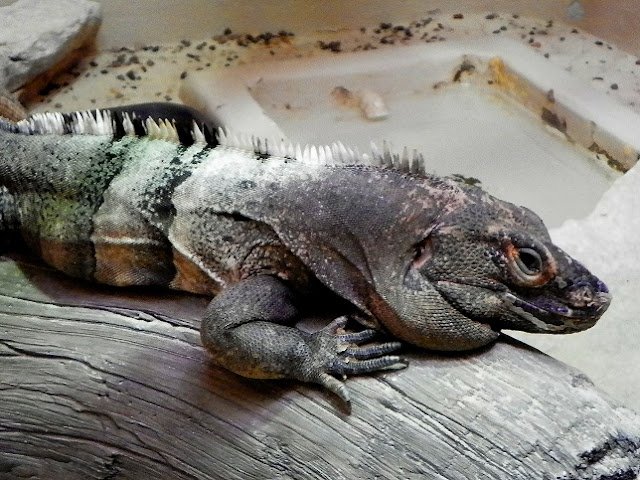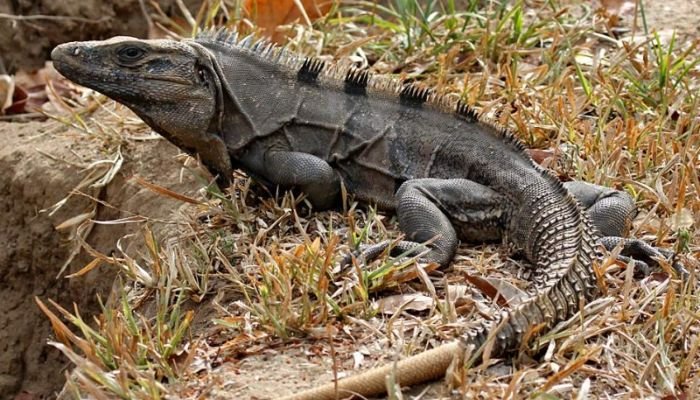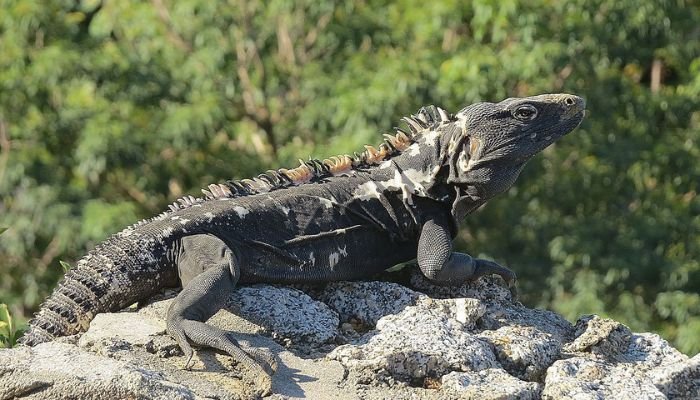
The spiny-tailed iguana, also known as the “black spinytail” or spiny-tailed iguana, is a popular reptile due to its peculiar appearance and intriguing behavior. These reptiles are primarily found in the arid regions of Mexico and Central America, where they thrive.. Here are Spiny-tailed iguana Guide on Food, Habitat, Size, Lifespan & Predators below-
Spiny-tailed iguana Stats in Table format
The stats are given below for Spiny-tailed iguana
| Reptiles List | Spiny-tailed iguana |
|---|---|
| Family | guanidae |
| Type | Lizard |
| Size | Medium to Large |
| Length | Spiny-tailed iguana: Up to 4-5 feet (1.2-1.5 meters) |
| Color | Spiny-tailed iguana: The color varies depending on the species, but spiny-tailed iguanas can have shades of brown, gray, or green with patterns or markings. |
| Weight | Spiny-tailed iguana: Usually weighs between 1 to 2 pounds.. |
| Lifespan | 15-20 years (or more) |
| Reproduction | Oviparous, lays eggs |
| Gestation Periods | The gestation period for spiny-tailed iguanas is approximately 65 to 75 days. |
| Endangered Status | Least Concern (IUCN Red List) |
| Features | Spiky scales on the tail, strong limbs for climbing |
| Country & Areas | Mexico, Central America, South America, Caribbean islands, Florida Keys, and the Cayman Islands. |
Spiny-tailed iguana Natural Habitat and Distribution
Mexico, Guatemala, Belize, Honduras, Nicaragua, Costa Rica, Panama, and other countries in the tropics and subtropics of Central and South America are all common locations for spiny-tailed iguanas. They can be found in a wide variety of habitats, from tropical forests and savannas to rocky shorelines and arid deserts. Critical variables influencing their distribution are the accessibility of basking sites, hiding spots, and sufficient food sources.
Spiny-tailed iguana Physical Features and Adaptations
Spiny-tailed iguana Physical Features and Adaptations
1. Body Structure
The spiny-tailed iguana is a muscular and slender lizard of middle size. A long, tapering tail adorned with rows of spiky scales is a distinguishing feature of these creatures. The tail acts as a weapon in the fight against predators.
2. Coloration and Patterns
These iguanas come in a variety of green, gray, brown, and black colorations and patterns. Some species have elaborate patterns on their bodies to help them hide in their environment and evade predators.
3. Defense Mechanisms
Several defensive behaviors are shown by spiny-tailed iguanas when they feel threatened. In the first place, they employ the force of their tails to strike quickly and painfully at potential predators. In addition, they can defend themselves by hissing, puffing up, or slashing with their sharp claws.
Spiny-tailed iguana Diet and Feeding Habits
Spiny-tailed iguana Diet and Feeding Habits
1. Diet Type
Herbivores like spiny-tailed iguanas get the bulk of their nutrition from plants. They are folivores, meaning they eat mostly leaves but also flowers, fruits, and young shoots.
2. Preferred Food Sources
Spiny-tailed iguanas’ diets are as unique as their tails, adapting to seasonal changes and local food availability. Hibiscus flowers, cactus pads, vegetables (like kale and collard greens), and fruits (like mangoes and papayas) are all frequent dietary sources.
3. Feeding Schedule
Spiny-tailed iguanas kept as pets require feedings once every other day, if not more frequently. Children may need to be fed more frequently than adults, who can go longer between meals. Including sufficient calcium and vitamin supplements in the diet is crucial.

Spiny-tailed iguana Housing and Enclosure Requirements
Spiny-tailed iguana Housing and Enclosure Requirements
1. Terrarium Size and Setup
Spacious cages are necessary for spiny-tailed iguanas because of their high activity levels. An adult requires a terrarium that is at least 6 feet in length, 3 feet in width, and 6 feet in height. The enclosure needs basking spaces, hiding places, and places to climb.
2. Substrate Options
Organic topsoil, cypress mulch, and reptile-safe sand are all great components of a substrate for your reptile. The substrate should be suitable for burrowing and should mimic the iguana’s native habitat.
3. Temperature and Lighting
Ectothermic animals like spiny-tailed iguanas must rely on environmental heat sources to maintain a constant internal temperature. It’s recommended to supply both a warm basking space in the 95–100°F (35–38°C) range and a cooler region in the low 80s°F (27–30°C). For optimal health and calcium metabolism, full-spectrum UVB illumination is required.
4. Humidity and Water Needs
The humidity level is not crucial for the survival of spiny-tailed iguanas. However, a modest water dish for drinking and sometimes soaking needs to be provided. Make sure there is enough airflow in the enclosure to avoid condensation.
Spiny-tailed iguana Behaviour and Temperament
Spiny-tailed iguana Behaviour and Temperament
1. Activity Levels
Diurnal animals like spiny-tailed iguanas are awake and about during the day. They use sunbathing as a method of thermoregulation and are also adept climbers and speedy runners.
2. Social Behaviour
Iguanas with spines on their tails are typically solitary. Multiple iguanas should not be kept together in captivity since it increases the likelihood of territorial disputes and stress.
3. Handling and Taming
Spiny-tailed iguanas can be trained to be tame and friendly if handled regularly beginning at an early age. Care must be used when handling them, though, because they are easily startled.
Spiny-tailed iguana Breeding and Reproduction
Spiny-tailed iguana Breeding and Reproduction
1. Mating and Courtship Rituals
During the rainy season, when food is plentiful, spiny-tailed iguanas often have their young. Courtship rituals include head bobbing and territorial displays, both of which are used by males to woo potential mates.
2. Incubation and Hatchlings
After mating, the female will dig a nest in the ground and put her eggs inside. Depending on the species and the conditions, incubation might last anywhere from 60 days to 90 days. The young are on their own as soon as they hatch and must learn to survive.
Spiny-tailed iguana Common Health Issues and Veterinary Care
Spiny-tailed iguana Common Health Issues and Veterinary Care
1. Respiratory Infections
If the iguana’s environment is overly humid, or if there are sudden shifts in temperature, it may have a respiratory illness. A respiratory infection might manifest with wheezing, fatigue, and nasal discharge.
2. Parasites:
Spiny-tailed iguanas are susceptible to internal and external parasites if they are housed in dirty conditions. Regular cleaning of the enclosure and inspection of the feces can help keep parasite populations in check.

3. Metabolic Bone Disease
Metabolic bone disease, which affects the iguana’s skeleton, can be caused by insufficient calcium and ultraviolet B (UVB) supplementation. It can lead to a weakened body and even fractures if left untreated.
Importance of Regular Vet Check-ups
Spiny-tailed iguanas, like all animals, benefit greatly from routine veterinarian examinations. A vet with experience with reptiles is the best person to determine whether or not your scaly friend is healthy, give you advice on what to feed them, look for parasites, and make sure their habitat is adequate. By identifying and treating health problems early on, these interesting creatures can live longer and better lives.
Conclusion:
The fascinating spiny-tailed iguana possesses a wide variety of morphological and behavioral features, making it stand out among other reptile species. Prospective owners can provide these exotic animals the best care possible by learning about their natural environment, diet, housing needs, behavior, and health concerns. Keep in mind that part of being a good pet owner is making sure your pet has a clean and safe place to live, fresh water, a healthy diet, plenty of playtime with other animals, and frequent visits to the vet. Spiny-tailed iguanas can flourish and become fantastic pets for anyone who provide the proper care and attention.
FAQs
Q: What is the family and Type of a Spiny-tailed iguana?
Spiny-tailed iguanas belong to the genus Ctenosaura and the family Iguanidae.
Q: What is the average size of a Spiny-tailed iguana?
The average length of a Spiny-tailed iguana, tail included, is between 2 and 3 feet (60 and 90 centimeters).
Q: How long can a Sulcata tortoise grow in size and length?
Sulcata tortoises can reach lengths of 30 inches (75 centimeters) and weights of 200 pounds (90 kilograms) or more in captivity.
Q: What colors do Spiny-tailed iguanas come in?
The majority of spiny-tailed iguanas are dark in color, but some have lighter bands or patterns on their bodies.
Q: How big can a Sulcata tortoise get in weight?
The adult weight of a Sulcata tortoise can range from 45 to 90 kilograms (about 100 to 200 pounds).
Q: How long do Spiny-tailed iguanas live?
A: Spiny-tailed iguanas typically only survive 10–15 years in the wild, but can reach 20 years or beyond with the right kind of care and maintenance.
Q: How do Spiny-tailed iguanas give birth?
Spiny-tailed iguanas, like many other lizards, lay eggs. Women lay their eggs in nests they’ve dug in the ground, and then they leave the eggs to develop on their own.
Q: How long is the gestation period for a Spiny-tailed iguana?
Since spiny-tailed iguanas reproduce asexually by laying eggs rather than giving live birth, there is no gestation period for these reptiles.
Q: Is the Sulcata tortoise endangered?
The Sulcata tortoise, also known as the African spurred tortoise, is in danger of extinction because of habitat destruction and the illicit pet trade, so the answer is yes.
Q: What are the prey of Spiny-tailed iguanas?
To answer your question, the vast majority of a spiny-tailed iguana’s diet consists of leaves, flowers, fruits, and vegetables.
Q: Do Spiny-tailed iguanas have any Predators?
A: Yes, snakes, foxes, and raccoons, among other creatures, prey on Spiny-tailed iguanas. Birds of prey and larger reptiles also pose a threat.
Q: How Fast Does a Spiny-tailed iguana Move?
Spiny-tailed iguanas are nimble reptiles that can sprint up to 20 miles per hour (32 kilometers per hour) when threatened.
Q. What is Bite Force of Sulcata tortoise in PSI?
Sulcata tortoises are not as widely studied as larger reptiles or carnivores, but it is safe to assume that their bite force is low.
Q. Can we keep Spiny-tailed iguanas as pets?
Yes, but only with certain accommodations including a spacious enclosure, the right food, and UVB illumination.
Q. Are Spiny-tailed iguana good for pest control?
A: Spiny-tailed iguanas are not good at controlling pests in the conventional sense because they eat mostly plants.
Q. Do Spiny-tailed iguana s require a UVB light source?
I hope you like reading on Spiny-tailed iguana FAQ Guide on Food, Habitat, Size, Lifespan and Predators.
